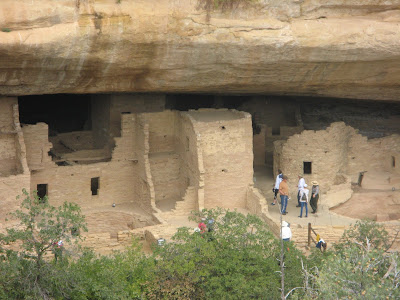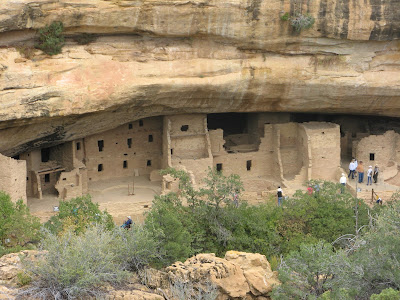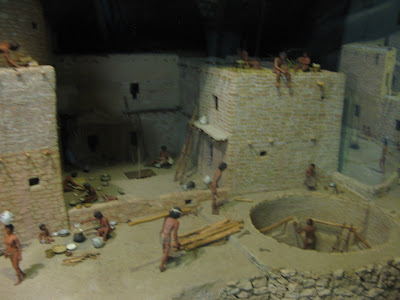The journey was very scenic and the landscape changed from the untamed desert area that we had got used to to a greener and lusher landscape. Mountains and mesas and hills continued to feature and generally it was all very lovely. Here are some views along the way:
Chimney Rock
Twin Buttes
Outside an Indian Trading Post
This is Mesa Verde. I didn't realise until we got into the park that we would be ascending, on a circuitous route, right up there! And the fascinating thing is that there is so much to see in what seems to be just a climb up. There are canyons and valleys and hills aside from the cliff dwellings that we were there to see.
Outside the Visitor Centre
These exhibits in the Visitor Centre are designed to give an insight into the ancient puebloan culture and way of life.
Snow on the mountains in the distance
From the Visitoe Centre we drove along the route stopping at all the viewpoints. The Park road was very twisty with sharp curves and steep inclines.
There were great views into the valleys. This was Montezuma Valley overlook. I was fascinated by the story of the first tourists and how precarious the journey was.
This was at Park Point overlook, the highest point in the park at 8572 feet. There is a fire lookout post here (where the crow is perched) as the whole area can be seen. Lightning is the major cause of fires. And there was lightning today! In fact with the amount of thunder and lightning there was and the heaviness of the sky we were very lucky not to have a downpour that would destroy our visit. The rain stayed off until we were back in the car and well on our way to the bottom again.
Views from Far View area
About AD 55 0, long before Europeans explored North America, some of the people living in the Four Corners region (where New Mexico, Colorado, Utah and Arizona meet) decided to move onto Mesa Verde. For over 700 years these people and their descendants lived and flourished here, eventually building elaborate stone communities in the sheltered alcoves of canyon walls. In the late 1200s they left their homes and moved away. Mesa Verde National Park preserves a spectacular reminder of this ancient culture.

Local ranchers first reported the cliff dwellings in the 1880s and since then archaeologists have been trying to understand the lives of the people who lived there. The cliff dwellings speak of a people adept at buildings, artistic in their crafts, and skilful at making a living from a difficult land. The structures give evidence of a society that, over centuries, accumulated skills and traditions that were passed on from generation to generation.
The Classic Pueblo Period was from 1150 to 1300. Using nature to their advantage, the Ancestral Pueblo people began to build their villages beneath the overhanging cliffs. They used sandstone that they shaped into blocks. The mortar between the blocks was a mix of dirt and water. Spruce Tree House was one of the largest villages in Mesa Verde with 130 rooms and 8 kivas. Some 60 to 90 people lived here at any time.
The Pinyon Pine is the State tree of New Mexico but grows also in the Four Corners Region.
After our stop and walk at Spruce Tree House we did the Mesa Top Loop as the skies got increasingly ominous. Then we made our way down again through spectacular views and onto the road for Cortez where we were staying the night at the Retro Inn. We were both glad to get to bed, particularly Jim because of all the heavy driving.





















































No comments:
Post a Comment